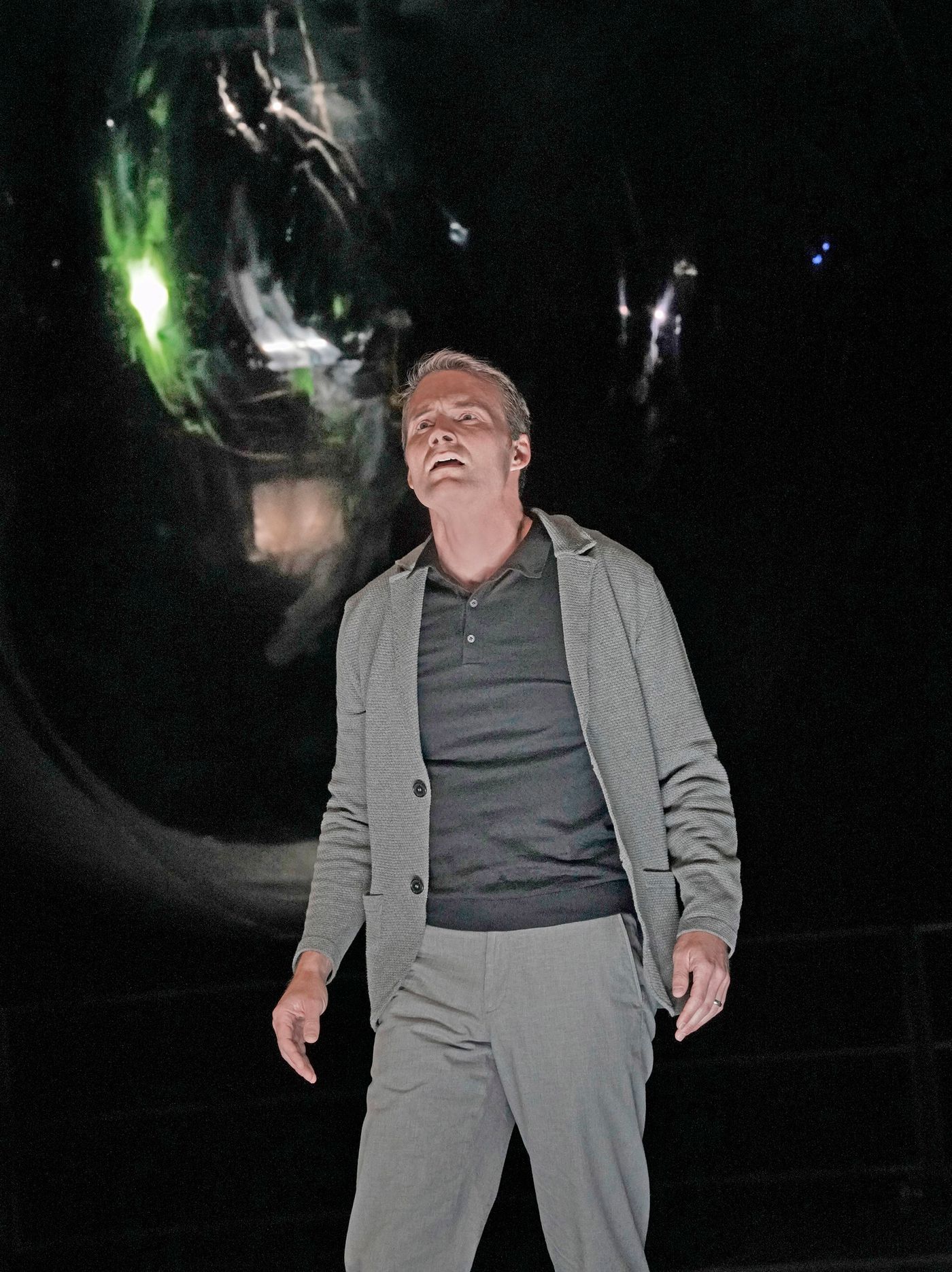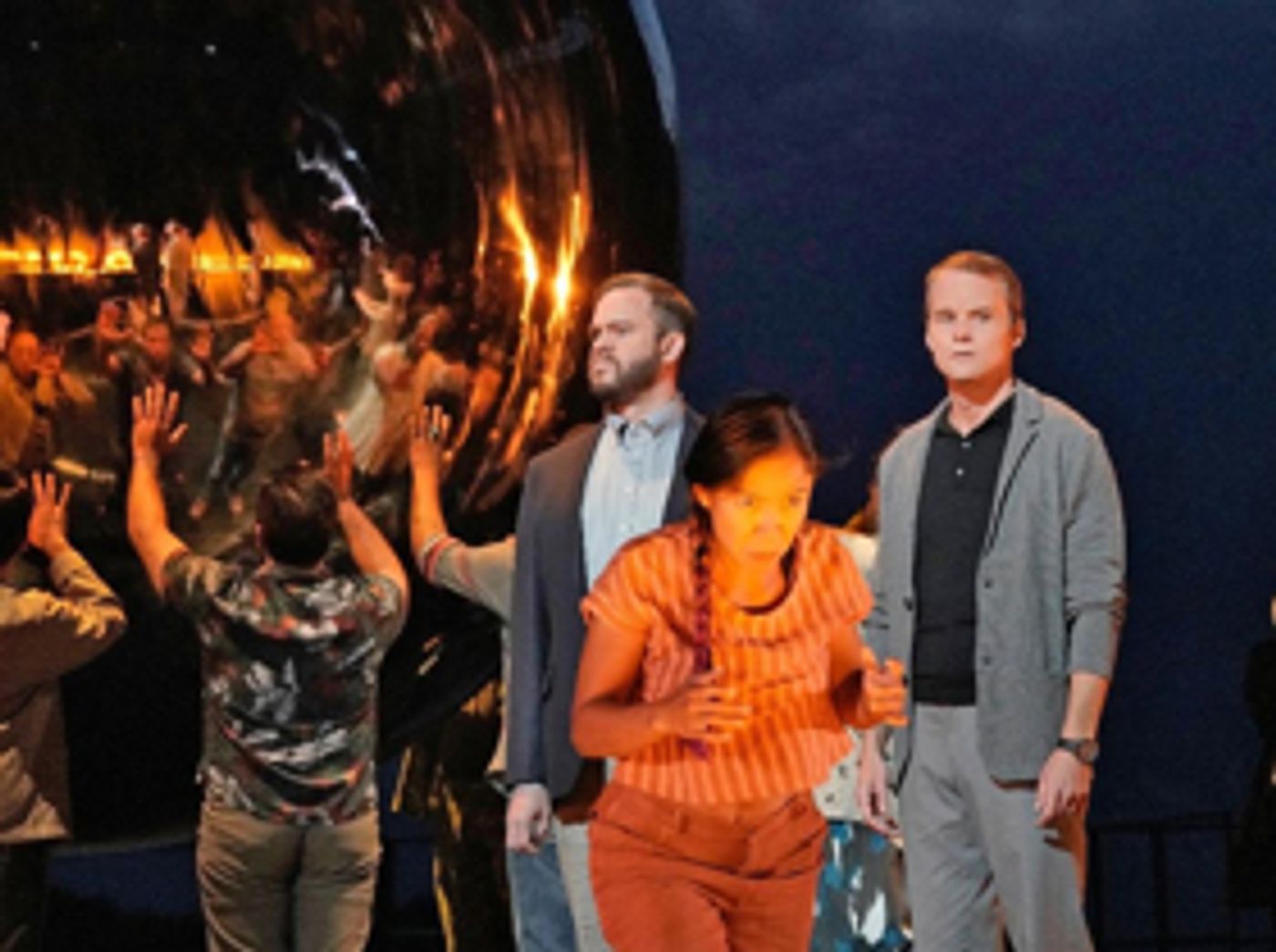Review: DOCTOR ATOMIC at Santa Fe Opera
 On July 28, 2018, 13 years after its premiere, Santa Fe Opera presented John Adams and Peter Sellars' DOCTOR ATOMIC. This new production featured bass-baritone Ryan McKinny as the volatile scientist J. Robert Oppenheimer. The opera, which takes place during the last few days before the first atomic bomb test, shows Oppenheimer battling with his mental demons as he tried to deal with the impending use of his scientific discovery to destroy an entire city and its inhabitants. McKinny showed the audience the human side of the scientific genius and I doubt that operagoers who saw his portrayal will soon forget it.
On July 28, 2018, 13 years after its premiere, Santa Fe Opera presented John Adams and Peter Sellars' DOCTOR ATOMIC. This new production featured bass-baritone Ryan McKinny as the volatile scientist J. Robert Oppenheimer. The opera, which takes place during the last few days before the first atomic bomb test, shows Oppenheimer battling with his mental demons as he tried to deal with the impending use of his scientific discovery to destroy an entire city and its inhabitants. McKinny showed the audience the human side of the scientific genius and I doubt that operagoers who saw his portrayal will soon forget it.
Before the opera began, three local Pueblos, Santa Clara, San Ildefonso and Tesuque presented a Corn Dance as an offering of healing for the communities that were affected by the bomb tests. Pueblo dancers were men, women, and children, some as young as five or six years old, wearing feathers, furs, and other colorful regalia. They danced to different drum rhythms and the singing of several bronze-voiced men for about 20 minutes before the opera started.
The opera opens with the chorus of scientists, engineers and military personnel singing about Einstein's discoveries and how they made the bomb possible. There is little scenery except for a large shiny ball that shows the reflections of people on stage and in the audience. It seemed to be a sample of the people whose lives would change with the explosion of the bomb. Because the bomb was always on the minds of the singing actors, the ball appeared more dominant as time went on.
Teller and Wilson tell Oppenheimer of their moral problems with the government  using their research to make a bomb. Oppenheimer says their objections border on treason. In the next scene, he is home with his bored, alcoholic wife, Kitty, sung by silver voiced soprano, Julia Bullock. When she asks "Am I in Your Light? No? Go on reading." He does go on reading because he is troubled, but eventually he makes passionate love to her.
using their research to make a bomb. Oppenheimer says their objections border on treason. In the next scene, he is home with his bored, alcoholic wife, Kitty, sung by silver voiced soprano, Julia Bullock. When she asks "Am I in Your Light? No? Go on reading." He does go on reading because he is troubled, but eventually he makes passionate love to her.
For the last scene of Act I, the project has moved some thirty miles from Los Alamos to Alamogordo. When an incoming scientist asks how to find the route, he is told to merely follow the beer cans. The bomb is ready for testing, but the project is threatened by thunder and lightning that could set it off unexpectedly. The officious General Groves, sung with gusto by Daniel Okulitch, says the test has to go off as scheduled and he tries to bully meteorologist Frank Hubbard into predicting good weather. Hubbard, sung by resonant-voiced baritone Tim Mix, however, stands his ground. Mackenzie Gottcher as Captain Nolan effectively completed the group at Alamogordo.
By this time, McKinny as Oppenheimer is severely troubled and with golden baritonal sounds he sings lines of John Donne that begin: "Batter my heart, Three-Person'd God." Although Adams's music does not lend itself to a great deal of traditional opera singing, on this evening this soliloquy became a truly memorable aria.
Act II opens with Kitty and her housekeeper, Pasqualita, sung by rich-voiced contralto Meredith Arwady, tending to Kitty's baby. Kitty sings dramatically of war and death while Pasqualita sings the baby to sleep with a soothing Pueblo song that shows off her deep purple velvet low notes.
Scene II is at the Test Site where tenor Ben Bliss as Robert Wilson is up on an enormous ladder checking the bomb's connections. Andrew Harris as Edward Teller reminds everyone that some scientists say the bomb could set the air on fire and thus destroy the earth. Oppenheimer manages to convince his colleagues that the theory has been proved false. He goes home to Kitty and Scene III includes his vision of Vishnu and more dances by Pueblo dancers. This time, however, they are accompanied by Adam's orchestral music instead of drums and masculine song.
At last the weather has cleared and the test can go forward. The ball is lower and appears even more prominent while reflecting red and white light. As the orchestra reaches fortissimo and the tension rises to a breaking point, we realize the bomb has exploded. The last sound we hear is a mother asking for water for her children in Japanese.
Adams and Sellars told the story of DOCTOR ATOMIC with dance as well as with song. Wise Fool, along with Justin Geihm, Anne Pesata, Mina Radfarr, Jasper Shorty, and Jean-Paul Weaver, added to the ambiance of many scenes. Although conductor Matthew Aucoin worked with large forces, he kept the music transparent and never let the players cover the singers. He also brought a great deal of drama to the stage with his huge range of dynamics. This is a stunning production of an important opera and I hope to see it in many other opera houses in the near future. Performances at Santa Fe Opera can be seen on August 2, 7, and 16.
Photos: Andrew Harris as Edward Teller and Ryan McKinny as J. Robert Oppenheimer with dancers and Ryan McKinny as Oppenheimer by Ken Howard for Santa Fe Opera.
Reader Reviews
Videos

